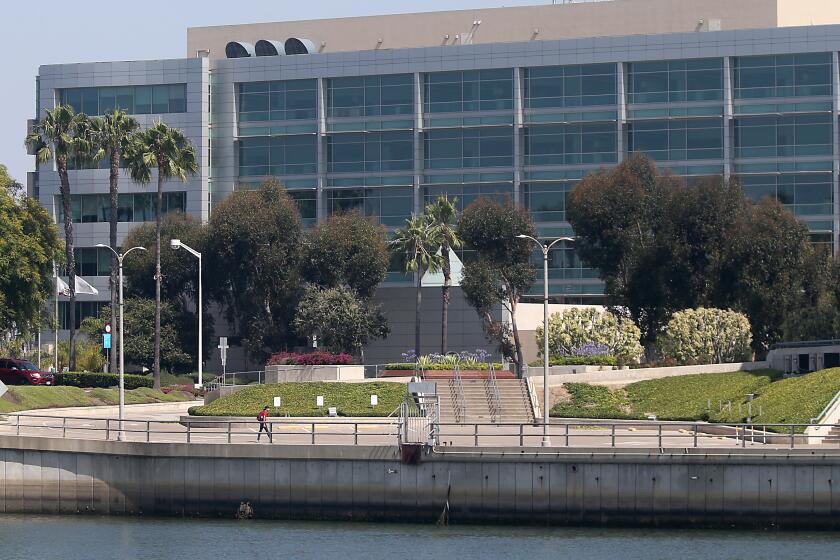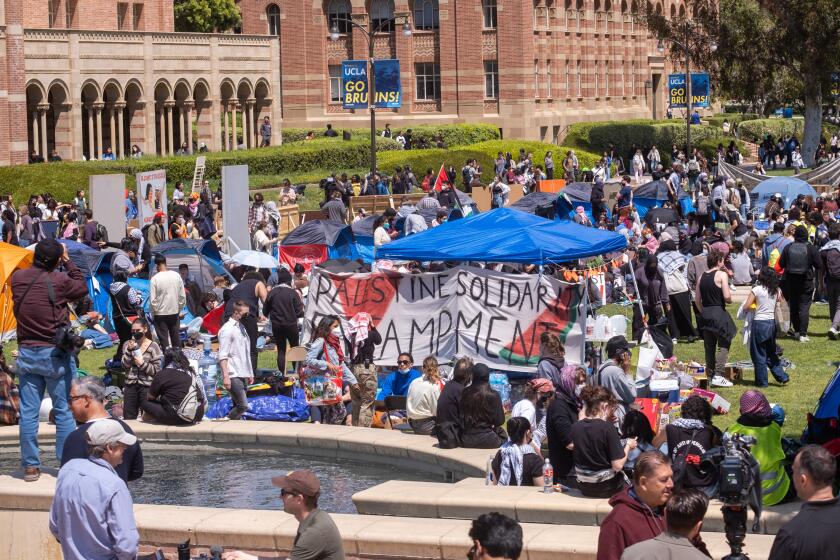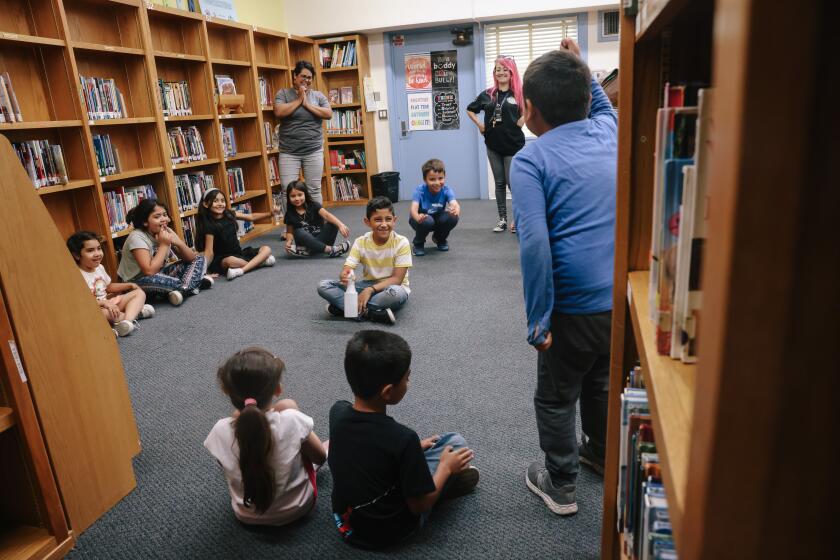Turning Around Low Achievers : L.A. Schools’ Challenge: New Leaf for Black Pupils
At the corner of 115th Street and Success Avenue, just inside one of the city’s roughest housing projects, first-grade teacher Morris McFadden paused to consider the task that lay before him and his fellow teachers at 112th Street School.
They had just spent an hour knocking on doors at Nickerson Gardens, a ramshackle mini-city of 5,000 people, notorious as a haven for gangs, drugs and crime. The teachers had come to let people know that school will be starting two weeks earlier than most other schools.
Many parents said they already knew. But one mother contacted during the walk last week said that she will not let her child attend 112th because of violence at the school. McFadden, who has taught in inner-city schools for five years, said he shared her concern. Sometime in the last few weeks, the knobs on his classroom doors were hacked off by vandals.
None of that appeared to discourage the teacher, however, because he was buoyed by the excitement of starting something new. For 112th Street and nine other South Los Angeles schools, an experimental program begins Monday that the Los Angeles Unified School District hopes will dramatically improve the quality of education for many of the black children living in the city’s impoverished core.
“I’m excited. I love teaching,” McFadden said, “and I think we’re going to see a big difference.”
With $5.5 million in federal, state and district funds, the district has launched--with much ballyhoo--a five-year program to reverse the pattern of low achievement at 10 predominantly black elementary schools.
The key components of the Ten Schools Program are a longer school year, reduced class size in kindergarten through second grade, a curriculum that emphasizes strong language skills, intensive parent involvement and allowing teachers to make decisions affecting school policies and operations. In addition, each school was reorganized, with the majority of schools receiving new principals. At every school, a committee of parents, teachers and administrators handpicked the faculty from a pool of district teachers who volunteered for the jobs.
The goal is to achieve math and reading test scores at the end of the five years that are at least as high as the national average. The challenge is formidable, but the district is gambling on a victory.
“This school district is on the line,” said Associate Supt. Paul Possemato, a veteran district administrator who helped conceive the program. “Either it can teach poverty children, or it can’t. If (it) cannot, then the system has to be bankrupt.”
The project has attracted considerable interest because it brings together for the first time a number of approaches that research has shown to be effective, authorities on minority education say.
‘Seeds Are There’
“From what we have seen,” said Susana Navarro, associate director of the Achievement Council, an Oakland-based nonprofit group that promotes and monitors efforts to improve education for poor and minority youngsters, “the seeds are there for tremendous success.”
Owen Knox, a retired Los Angeles school district administrator who co-chairs the National Conference on Educating Black Children, a group of black educators concerned about the quality of education black youngsters receive, said he has high hopes for the program.
“There is such a necessity for it to succeed,” he said, “because there isn’t a large school district in the country having success in educating poor children. This could be a model program for that.”
The 10 schools chosen for the program are 36th Street, 93rd Street, 96th Street, 97th Street, 102nd Street, 112th Street, Flournoy, Compton Avenue, Martin Luther King and McKinley Avenue. All have a large percentage of Latino youngsters but are predominantly black.
They are not the 10 worst schools in the district. Indeed, there are a number of schools--many with primarily Latino enrollments--that were not included in the novel project but have records just as poor.
The program was limited to predominantly black schools, Possemato said, because “we had a request to look at the educational needs of black children in poverty.” The request, which was more of a demand, came from eight black community leaders who approached the district last year with virtually the same laundry list of improvements they said were needed.
“We wanted an attitude change toward the black child,” said Dorothy Rochelle, president of the Watts-based Advocates for Black Children. “Our children can learn” if they are given optimum classroom conditions.
The district--which still faces a longstanding NAACP desegregation lawsuit alleging discrimination against black students--responded by identifying 10 schools that met certain criteria. Each school had to have at least a 60% black enrollment and, based on standardized test scores, had to fall in the bottom ranks academically. In addition, the district looked for predominantly black schools that had received substantial federal and state assistance to raise achievement but had demonstrated no significant progress over a period of years.
Failures Documented
Filed away in district offices are volumes of studies documenting the district’s failure to reverse years of academic stagnation in its predominantly black schools. According to a 1986 report by an outside evaluation team, students in the district’s poorest and most racially isolated campuses scored far below district norms on last year’s comprehensive tests of basic skills, and scores appeared to drop the higher the grade level.
The test, which allows comparisons to other schools nationally, showed that the 10 South Los Angeles schools chosen for the experimental project ranked at the 30th percentile or lower in mathematics and reading skills, which means that at least 70% of students nationally who took the same test scored higher.
The poor marks have persisted despite the millions of dollars funneled into those schools since the 1960s through the federal government’s Chapter 1 program for impoverished students. Those funds paid for special reading programs, extra classroom aides and other support services. The schools apparently also derived little benefit from more than a dozen court-ordered programs that the district was directed to devise to ease the effects of racial segregation. These programs, drawn up as part of the district’s integration plan, addressed a welter of problems, such as insufficient textbooks and high turnover of teachers.
District officials say the new approach proposed in the Ten Schools Program will work because it is based on extensive research, much of which reflects the “effective schools” movement of the last several years. That school of thought has its roots in the writings of the late Ron Edmonds, a black Harvard University educator who believed that all children are capable of learning if schools have strong principals, an orderly and safe environment and high expectations.
To that basic framework, the district has added a longer school year, Saturday “learning clinics” for students and their parents, and an approach to teaching that emphasizes mastery of oral and written language skills.
500 Teachers Involved
All of the 500 classroom teachers involved in the program will use this approach to help students learn to speak, read, write and think in standard English instead of the black vernacular that is so widely used on the streets of South-Central and South Los Angeles. It means that students will be learning how to use language in every part of the curriculum, instead of focusing on such skills only during a reading or English lesson, said Assistant Supt. Barbara Smith, who is overseeing the program.
In other words, a math teacher will incorporate a vocabulary lesson into a session on solving word problems, or a social studies teacher will assign a novel, such as “Little House on the Prairie,” as part of a lesson about the settlement of the West.
This approach embodies what good teachers normally do, Smith said. The difference in this program is that all teachers in the Ten Schools Program have been specifically directed--and trained--to use it.
The program also advocates using grade-level textbooks and other materials. While that does not sound like it will be an extraordinary accomplishment--to use, for instance, a 5th-grade book in a 5th-grade class--it will be a major step forward in these schools, Smith said. In many underachieving minority schools where students’ reading and writing skills often fall below grade-level expectations, it is all too common for a 5th-grader to be given a 2nd- or 3rd-grade text. That practice, although well-intended, often causes low self-esteem and perpetuates poor achievement, education experts say.
The only opposition to the program has come from United Teachers-Los Angeles President Wayne Johnson, who contends that the district has rushed into the project with inadequate preparation. He also charged that the district has failed to attract the most highly qualified teachers and principals.
Indeed, the district was not overwhelmed by applications from veteran teachers or principals. Officials speculated that many potential participants did not want to work the longer year or feared the extra-close scrutiny the 10 schools will receive. At some of the designated schools, more than 50% of the teachers decided to leave.
The response from principals was particularly underwhelming. District officials had invited 50 outstanding elementary principals to apply, but only 18 came forward, four of whom had to be recruited, according to Possemato.
Only three of the original 10 principals at the schools survived the screening by a district committee. Of the new principals, three have little or no experience running a school, although they have served in other administrative posts. “That tells you something isn’t right,” Johnson said.
Dedication Emphasized
However, district officials, teachers and parents involved in the selection process disagreed. They said the staff’s dedication, rather than experience, will be the determining factor in the success of the Ten Schools Program.
“I just wanted to be sure the commitment was there,” said Claudia Moore, a parent who sat on the teacher selection committee at 112th Street School. The Nickerson Gardens resident said she had been planning to send her 5-year-old son to another school away from the neighborhood because she was dissatisfied with ineffective teachers she had encountered at 112th in the past. Now, because of the new program, “I’m willing to give it a chance,” she said, “but my child must learn while he’s here.”
At 112th Street, the poorest of the 10 schools, enthusiasm appeared to be running high.
“There is a heavy ‘buy-in’ component,” said 4th-grade teacher Anthony dal Piaz. “Teachers are not going to be in their room, doing their own thing. We have a team effort . . . that will be contagious.”
For Principal Roberta Woodson, who is one of the three novice principals, there were anxious feelings, too. One day last week, she watched as a bevy of top school district brass, who normally leave final inspections to subordinates, marched through the campus, frowning at a few missing floor tiles and broken lights and checking for dust on bookshelves and desk tops. Mostly from years of neglect, the school was far from being in top shape; even the flags flying above the school were faded and frayed.
“We’re in a fishbowl,” she said. “That means you got to be on your toes. But this is exciting, to be on the cutting edge of public education for needy kids. I can’t think of a better place to be.”
More to Read
Start your day right
Sign up for Essential California for news, features and recommendations from the L.A. Times and beyond in your inbox six days a week.
You may occasionally receive promotional content from the Los Angeles Times.







